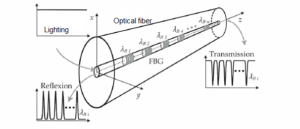 A team of researchers from the U.S. continues developing a fiber optic sensor based on fiber Bragg grating or FBG technology that helps to study tissue growth in the lab. The operating principle of the FBG sensor is based on a light-based signal to measure pH that is considered to be a highly important quality in cell-growth studies.
A team of researchers from the U.S. continues developing a fiber optic sensor based on fiber Bragg grating or FBG technology that helps to study tissue growth in the lab. The operating principle of the FBG sensor is based on a light-based signal to measure pH that is considered to be a highly important quality in cell-growth studies.
It should be noted that compared to traditional sensing systems, it is possible to use the fiber sensor to control the environment in cell culture for weeks at a time without the necessity to bother the cell-growth environment. For several years, the researchers have designed photonic sensors that apply optical fibers etched with a fiber Bragg grating (FBG). Temperature or pressure changes lead to transform the wavelengths that are able to get through the fiber Bragg grating.
Such a sensing system has been already tested and shows that fiber sensors with Bragg gratings can be easily adapted to pH measurement. The application of a fiber optic-based platform featuring FBGs promotes the development of a fiber optic sensor that “measures the heat released by pH-sensitive chromophores upon absorption of light”.
Thus, due to this fiber sensing system, the researchers have succeeded to compare visible light absorption by the chromophores to the heat released and changes in the fiber Bragg grating signal over a pH range of 2.5 to 10. To be more precise, firstly, the team fills a petri dish with a solution made with red cabbage juice powder that transforms color in response to changes in pH. Then the researchers put one optical fiber above the dish, connecting the optical fiber to a laser pointer, and shine the laser beam into the sample.
Additionally, they install a second optical fiber with FBGs as the temperature sensor in the cabbage juice solution. Herewith, the team controls manually the pH levels in the solution. Shining the solution above, it absorbs the laser beam to different degrees depending on its pH level. The fiber optic sensor operates as a thermometer and detects these tiny changes in the juice’s heat.
A second color into the solution added by the researchers demonstrates that the fiber sensor offers its operation over a wide range. Moreover, further researchers show that the pH measurements by the FBG sensor are precise to plus or minus 0.13 pH units and are stable for at least three weeks.
Finally, it is planned to perform tests on “how cell cultures are affected by the slight, temporary temperature changes (about 1 to 2 kelvins) in localized areas of the sample that occur as a result of this measurement technique” by applying the developed fiber sensing system. Also, the temperature changes are required to reduce in the future as much as possible because over time the fiber sensors could be developed to control the growth of tissue in the human body
Optromix is a manufacturer of innovative fiber optic products for the global market. The company provides the most technologically advanced fiber optic solutions for the clients. Optromix produces a wide range of fiber optic devices, including cutting-edge customized fiber optic Bragg grating product line and fiber Bragg grating sensor systems. Moreover, Optromix is a top choice among the manufacturers of fiber Bragg grating monitoring systems. If you have any questions, please contact us at info@optromix.com


 Companies from the U.S. and Japan have developed for the first time a new
Companies from the U.S. and Japan have developed for the first time a new  Fiber optic technology
Fiber optic technology  A new compact
A new compact  A team of researchers offers a new application of
A team of researchers offers a new application of A team of researchers from Australia has developed a mathematical model, which is based on energy deposition and the laser-induced damage threshold (LIDT) for low-intensity light radiation resulting in the appearance of conducting polymers in novel
A team of researchers from Australia has developed a mathematical model, which is based on energy deposition and the laser-induced damage threshold (LIDT) for low-intensity light radiation resulting in the appearance of conducting polymers in novel  The opportunity to measure body temperature plays a crucial role in both physiological studies and clinical investigations. New wearable sensors based on
The opportunity to measure body temperature plays a crucial role in both physiological studies and clinical investigations. New wearable sensors based on  New improved accelerometers based on
New improved accelerometers based on  Nowadays the
Nowadays the  Fiber Bragg grating sensors
Fiber Bragg grating sensors